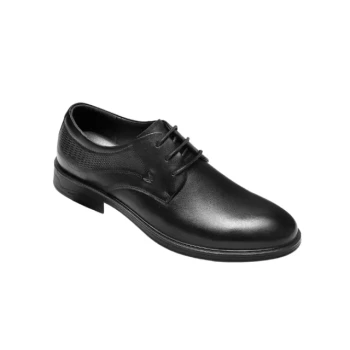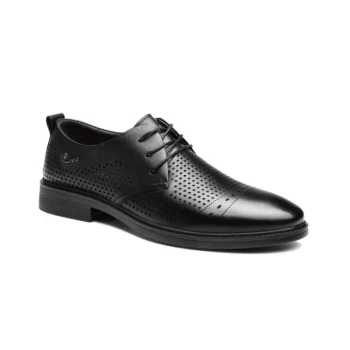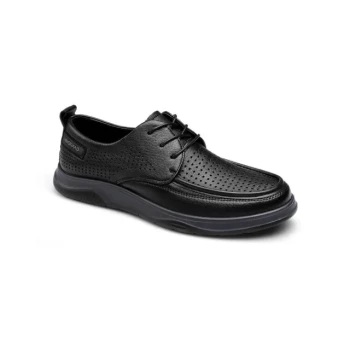The fundamental difference between Derby and Oxford shoes lies in their lacing system. A Derby has an "open" lacing system, where the pieces of leather with the eyelets are sewn on top of the shoe's vamp. An Oxford has a "closed" lacing system, where the eyelet tabs are stitched underneath the vamp, creating a sleeker, more formal appearance.
Your choice between an Oxford and a Derby is a choice between formality and versatility. The Oxford is the standard for formal and business wear, while the more relaxed Derby excels in a wider range of smart-casual and semi-formal situations.
The Defining Difference: Open vs. Closed Lacing
The construction of the shoe's lacing section, known as the "quarters," dictates its identity and level of formality.
Understanding the Oxford's "Closed" System
An Oxford shoe features quarters that are stitched underneath the vamp (the front part of the shoe).
This construction pulls the shoe together neatly, creating a clean, seamless look with a narrow "V" shape where the laces meet. This sleek silhouette is the reason it is considered the more formal of the two.
Understanding the Derby's "Open" System
On a Derby shoe, the quarters are stitched on top of the vamp.
This creates two flaps of leather that open up more widely, making the shoe easier to put on and offering a more relaxed fit. Its origins as a sporting boot in the 1850s speak to this more comfortable and robust design.
Matching the Shoe to the Occasion
Knowing the construction difference is key to selecting the right shoe for the right event.
When to Wear Oxfords: Formality First
The Oxford is the quintessential dress shoe for professional and formal settings.
Its clean lines pair perfectly with business suits for meetings, workdays, and interviews. A highly polished, whole-cut leather Oxford can even be worn with a tuxedo for black-tie events.
When to Wear Derbies: The Versatile Workhorse
The Derby's slightly more casual nature makes it incredibly versatile.
It's an ideal choice for semi-formal office environments and can bridge the gap between formal and casual. Derbies pair just as well with suit pants or chinos as they do with denim for a sharp weekend look.
Understanding the Trade-offs
Choosing the right shoe involves more than just the event; it's also about fit and avoiding common style missteps.
The Formality Spectrum
Remember that construction is just one factor. A brown suede Derby is far more casual than a black patent leather Oxford. The material, color, and sole type all influence the shoe's overall formality.
Fit and Comfort
The Derby's open lacing system is generally more accommodating for those with a high instep or wider feet. It allows for greater adjustment and can provide a more comfortable fit than the more restrictive Oxford.
Avoiding the Mismatch
The most common mistake is misjudging the formality of an event. Wearing rugged, casual Derbies with a formal business suit or tuxedo is a significant error. Conversely, wearing pristine patent Oxfords with jeans can look out of place.
Making the Right Choice for Your Wardrobe
Use your primary goal to guide your selection.
- If your primary focus is maximum formality and professional settings: An Oxford, particularly in black or dark brown leather, is the indispensable choice.
- If your primary focus is versatility for smart-casual and business-casual wear: A Derby offers the most flexibility, seamlessly pairing with everything from trousers to jeans.
- If your primary focus is a more accommodating fit: A Derby's open lacing system provides more adjustability and comfort, especially for wider feet.
Understanding this fundamental distinction empowers you to build a versatile and perfectly appropriate footwear collection.
Summary Table:
| Feature | Oxford Shoe | Derby Shoe |
|---|---|---|
| Lacing System | Closed (quarters under vamp) | Open (quarters on top of vamp) |
| Formality Level | High (Most Formal) | Medium to Low (Versatile) |
| Best For | Business suits, interviews, black-tie events | Business-casual, smart-casual, semi-formal events |
| Fit & Comfort | Sleeker, more restrictive fit | More accommodating, better for wider feet/high instep |
Ready to Stock the Perfect Shoe Collection for Your Customers?
As a large-scale manufacturer, 3515 produces a comprehensive range of footwear for distributors, brand owners, and bulk clients. Our production capabilities encompass all types of shoes and boots, including classic Oxfords and versatile Derbies.
We can help you source high-quality footwear that meets the precise demands of your market. Let's discuss your needs and how we can deliver value to your business.
Contact us today for a consultation!
Related Products
- Wholesale Comfortable Business Casual Shoes Custom Manufacturing
- Wholesale Leather Derby Shoes Manufacturer | Customizable Business & Dress Footwear
- Wholesale Leather Derby Dress Shoes Custom Manufacturer for Brands
- Custom Manufactured Air Cushion Leather Business Shoes for Wholesale
- Wholesale Breathable Perforated Leather Derby Dress Shoes for Custom Brands
People Also Ask
- How can one balance a casual outfit when wearing dress shoes? Achieve a Polished Smart Casual Look
- Is it acceptable to wear dress shoes with casual outfits? Elevate Your Smart Casual Office Style
- How should dress shoes be maintained to prolong their lifespan? A Guide to Lasting Quality
- What are the long-term benefits of investing in quality dress shoes? Save Money & Boost Your Style
- What is business casual shoes? Master the Perfect Blend of Professional Style and Comfort



















